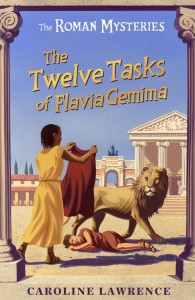By Caroline Lawrence (Wonders & Marvels contributor)
 When I was researching my sixth Roman Mystery, set during the mid-winter festival called the Saturnalia, I was amazed by how many ancient Roman customs have survived, embedded in our Christmas celebrations. Here are twelve!
When I was researching my sixth Roman Mystery, set during the mid-winter festival called the Saturnalia, I was amazed by how many ancient Roman customs have survived, embedded in our Christmas celebrations. Here are twelve!
1. Five day vacation. In the first century AD the Romans set aside five days holiday to celebrate the festival of the Saturnalia, a mid-winter pagan festival to bring back the sun. We take approximately the same number of days off for Christmas.
2. December 25th. Romans sacrificed to Saturn but by the first century some were celebrating the birth of an eastern god of light on the 25th of December. No, not Jesus: Mithras! His rites and rituals shared many similarities with our Christian ceremonies. There was a baptism, a sacramental meal, an observance of Sunday, and the god himself was born on the 25th of December
3. Christmas tree, mistletoe, wreaths, etc. Romans decorated their houses with greenery. As Sheldon from Big Bang Theory says, “In the pre-Christian era, as the winter solstice approached and the plants died, pagans brought evergreen boughs into their homes as an act of sympathetic magic, intended to guard the life essences of the plants until spring. This custom was later appropriated by Northern Europeans and eventually became the so-called Christmas tree.”
4. Lights & candles. Romans also decorated their houses with extra lights at this darkest time of the year. Again, this was a pagan attempt to bring back the sun. Torches, tapers, candleabra and oil-lamps flickered throughout the houses of the rich. Because of this Rome was a particular fire hazard in the winter. One historian estimates that a hundred fires broke out daily in the Eternal City, which had its own entire corps of firemen, the vigiles.
5. Feasting! In mid-winter instinct tells us to build up a nice layer of fat, to feast in preparation for lean times ahead. A bit like a bear before hibernation. Yum. Carbohydrates are on the menu again.
6. Drinking. It has been medically proven that a small amount of wine added to water will kill off most known bacteria. For most of the year Romans drank diluted wine, but during the Saturnalia they often drank neat wine, heated and spiced. That’s my excuse for a glass of mulled wine: it’s hygienic.
7. Partying & Role Reversal. For the five days of the Saturnalia, slaves didn’t have to work. They could eat, drink and be merry. Some masters let their slave switch roles. Others, like Pliny the Younger, just left them alone to get on with it. Today, office employees find Christmas the time when they are tempted to take the most liberty. Be careful. Once the Saturnalia is over, you have to go back to being a slave… er, employee.
8. Board games and/or cards. In first century Rome, the only time gambling was legally permitted was during the Saturnalia. Even children and slaves could roll dice for nuts or money without fear of punishment. In the West, Christmas is the only time many families play board games or cards.
9. Party pieces. On the first night of the Saturnalia many households threw dice to determine who would be the King of the Saturnalia. The “King” could command people to do things like prepare a banquet, sing a song, or run an errand. Today we often perform party pieces at our Christmas parties, but Mom usually gets landed with preparing the banquet.
10. Santa hats. Many Roman citizens wore the hats traditionally given to slaves when they were set free. The pileus or pileum – both forms are attested – showed that freeborn Roman citizens were “extra free” from the usual restrictions and laws. These “freedom caps” were conical in shape and made of colourful felt, perhaps fur-trimmed in the winter. Hmmm. A red felt conical hat trimmed with white fur. Remind you of anything?
11. Presents! The Romans gave gifts on the Saturnalia, especially small clay or wooden figures – sigillum singular, sigilla plural – often with moveable joints. Action figures, LEGO and Barbies are our modern equivalent!
12. Gift tags. Finally, Romans often composed two-line epigrams to accompany their Saturnalia gift. So come on all you NaNoWriMo graduates and would-be writers: try composing your gift tags as a two line poem!

Caroline Lawrence has been writing detective stories about first century Rome and the Wild West for over a dozen years. Her passion for plotting combined with an obession with historical accuracy means her history-mystery stories are popular with children, parents and teachers. Here she is at a Christmas booksigning, wearing her pileum or freedom cap.
This post was first published on Wonders & Marvels in December 2012.
